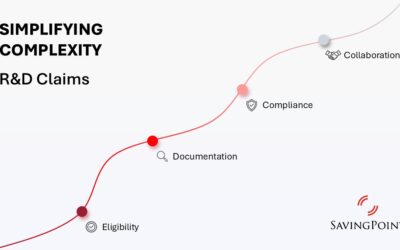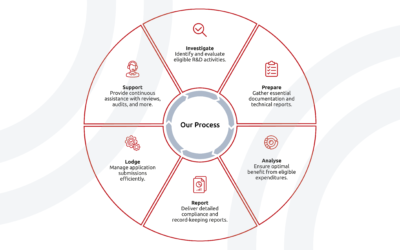Sustainability is no longer a ‘nice to have’ – it’s a priority for businesses striving to reduce environmental impact and meet growing stakeholder expectations. But achieving sustainability often means significant investment in new technologies, processes or materials. One question I hear often is: “can these projects qualify for the R&D Tax Incentive?”
The answer depends on how the project is structured. When aligned with the program’s requirements, sustainability projects can secure essential funding to offset costs while driving innovation. Here’s what you need to know.
What makes sustainability projects eligible for the R&D Tax Incentive?
It’s a misconception that all sustainability initiatives automatically qualify. To be eligible, a project must meet specific technical criteria, including:
- Technical uncertainty: The project addresses a challenge where the solution isn’t readily known or available.
- Systematic experimentation: A structured plan of testing or hypothesis-driven research is applied to solve the problem.
- Knowledge advancement: The work must result in new knowledge or the application of scientific or technical principles in an innovative way.
For example, a project developing biodegradable materials to replace plastics could qualify if it:
- Clearly defines the technical challenge, such as achieving durability while maintaining biodegradability.
- Uses systematic experimentation to test and refine solutions.
- Produces new insights or methods during development.
Projects focused solely on compliance with regulations or adopting existing technologies without modification are unlikely to qualify. However, innovative efforts to exceed regulatory standards often meet the criteria.
Addressing common misconceptions
Not every green initiative will tick the right boxes for the R&D Tax Incentive, but many do. Activities with strong experimental components, like the examples below, could qualify:
- Testing methods to recycle production waste into reusable materials.
- Developing alternative energy systems or fuel-efficient technologies.
- Refining manufacturing processes to significantly reduce emissions.
Every project is different, and eligibility depends on the specific technical challenges and experimentation involved. That’s where guidance can make all the difference.
Success with sustainability and the R&D Tax Incentive
To make these criteria more tangible, here’s an example of a business leveraging the R&D Tax Incentive to advance sustainability:
An Australian mid-sized manufacturing company sought to reduce its environmental impact by rethinking the use of virgin materials in its products. They embarked on an ambitious project to develop a 100% recycled material suitable for structural applications which was a significant technical challenge.
The project faced hurdles like achieving material consistency and ensuring compatibility with existing production processes. Through systematic experimentation and extensive trials, the company refined production techniques and developed a reliable, high-strength material sourced from waste plastics. This innovation not only reduced reliance on non-renewable resources but also resulted in a durable product that met industry standards.
By carefully documenting their experimental activities and addressing the technical uncertainties, the company qualified for the R&D Tax Incentive. This significantly offset their project costs while advancing their commitment to sustainability.
This example illustrates how aligning innovation with compliance can deliver both financial and environmental benefits.
The growing role of sustainability in R&D

Sustainability-related R&D continues to gain momentum, driven by the dual priorities of environmental responsibility and economic innovation. In Australia, our government’s commitment to achieving net-zero emissions by 2050 has strengthened significant investment in sustainability-focused research and development.
The Australian Government’s 2024–25 Budget highlights this focus through the $22.7 billion ‘Future Made in Australia’ package. This initiative is designed to attract private sector investment in key industries contributing to the net-zero transition, including renewable energy and green manufacturing. The package also includes the establishment of a National Interest Framework to streamline approvals for environmental and energy projects, enabling faster decision-making and implementation.
Additionally, targeted measures like the $17.3 million investment to mobilise private sector funding for sustainable activities reflect the nation’s strategic approach to fostering innovation. Programs such as the extension of Australia’s sustainable finance taxonomy to agriculture and the creation of a labelling regime for sustainable financial products further align economic growth with environmental goals.
These trends demonstrate that sustainability is no longer just about compliance, it’s about maintaining competitiveness in a rapidly evolving global market. Businesses that innovate in sustainability are meeting stakeholder expectations, attracting investment, and positioning themselves as industry leaders.
The R&D Tax Incentive remains a crucial tool for businesses pursuing sustainability-related innovation. By offsetting costs for eligible R&D activities, it provides financial backing for companies taking bold steps to develop solutions that contribute to a sustainable future.
How I help businesses combine sustainability with the R&D Tax Incentive
Bringing sustainability and the R&D Tax Incentive strategies together requires careful planning, analysis, and documentation. Here’s how I help businesses unlock funding for their green innovation:
- Identifying eligible activities: Reviewing projects to pinpoint the components that align with R&D criteria.
- Documentation support: Ensuring your claim is audit-ready by substantiating technical and financial details.
- Strategic insights: Advising on how R&D tax planning can integrate into broader sustainability goals for future initiatives.
This tailored approach ensures your business can make strong, compliant claims while staying focused on innovation.
Why this matters
Sustainability-focused projects often demand significant investment, whether you’re experimenting with new methods, refining processes or pushing technological boundaries. The R&D Tax Incentive provides a powerful way to offset these costs, allowing businesses to keep driving change while strengthening their financial position.
Understanding how sustainability initiatives align with the R&D Tax Incentive eligibility criteria can unlock meaningful benefits for your organisation. With the right guidance, you can maximise funding opportunities and continue making an impact.
Let’s talk about your sustainability projects
If your business is investing in innovative ways to reduce environmental impact, I’d be happy to discuss how these efforts might align with the R&D Tax Incentive. Let’s explore how your initiatives can drive both sustainability and business success.




